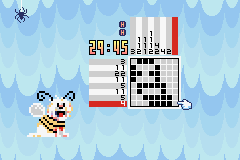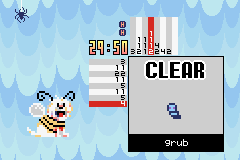Puzzle Pack Requirements
This page is for those who are working with RetroDotCards to do a puzzle pack collaboration. I made it public just in case anyone is curious what the process is like. If you are an indie game developer or indie artist and would be interesting in collaborating on a pack, let's talk!
Pixel Pup is a Nonogram game for the GBA E-Reader. It consists of a main card that contains the game engine. After the user has swiped the main card in, they then swipe in a "puzzle pack" card to load a set of puzzles to play. This page explains what is needed to build a successful puzzle pack card.
This is a lot of information, but the overall gist is simple. Create about 20-40 pixel art images. Those images become the puzzles in your pack.
Decide on the size of the pack
Either a full or half card
A puzzle pack can either be an entire card, or half of a card.


In reality, a puzzle pack is a single data strip. When a single puzzle pack takes up an entire card, it's technically two puzzle packs. But by making both puzzle packs thematically similar, it feels like one giant pack.
Number of puzzles
Shoot for about 20 puzzles per data strip
Each data strip can hold about 20 puzzles. So a half card puzzle pack is about 20 puzzles, and a full card about 40. The data on puzzle pack cards is compressed, so the exact number of puzzles that can fit on the card depends on how well the puzzle data compresses. Some packs might hold as little as 10 puzzles, others might be able to squeeze 30 in. When starting out, shoot to create 20 puzzles per data strip, and we'll adjust from there based on how much room is (or isn't) left over.
Puzzle Content
Make family friendly puzzles
Each puzzle is essentially low res pixel art with a name (more on names below). These images and names need to be family friendly. Shoot for "PG-13" content as the most risqué.
- Nothing violent.
- Nothing offensive, racist, sexist, hurtful, etc
- Any nudity must be very "light", if any at all.
- Nothing political or religious.
- Nothing about current events.
- Do not use other people's intellectual property, trademarked or copyrighted material.
Just keep the puzzles light hearted and fun and you should be fine.
Puzzle Sizes
Puzzles can be one of three sizes
15x15 puzzles take up more space on the data strip. 5x5 and 8x8 puzzles use about the same amount of space. In general don't add too many 5x5 puzzles to your pack. Maybe one or two to help beginners, and maybe none at all. For people familiar with nonograms, 5x5 puzzles are not very interesting.
Puzzle Palette
Puzzle images all use this palette
A puzzle is just a png image using this color palette:
The first ten colors are "highlights", and the last 5 colors are "solid." When the player solves your puzzle, they will be shown the puzzle image using this color palette. But when they are solving the puzzle, only the pixels in the image that are "solid" form the puzzle.
For example, in this puzzle image, the dark blue and purple eyes are part of the puzzle, and the light blue is not.
Here is that puzzle solved.

And here is how the full color image is shown to the player after they solve the puzzle.

It is possible to change up this palette if needed. Just let me know if you want to do that and I will add it to your pack.
Puzzle Names
Names can be 12 characters long
Each puzzle has a name, it is at most 12 characters long. Only these characters are allowed:
- A through Z, upper and lower case
- 0 through 9
- space
Puzzles need to be solvable
This one can be tough
Making a nonogram that is an interesting pic but still a legal nonogram can be challenging. Especially if you are new to making nonograms. This is a really helpful tool for this. I can also help you tweak your puzzles to ensure they are solvable and that the difficulty progression works within the pack. Expect this to be the most time consuming part of the process.
Puzzle Pack Background
Choose a background for your pack
Each pack needs to choose a background from the built in ones. Just find one you like and note its ID. The background can have a different palette, if you want to do that, just recolor the background as you like and I will set up the palette to match.
Puzzle Pack Background Music
Choose a song for your pack
Each pack needs to choose a music track from the built in ones. Sadly there is no easy way to sample the songs. I hope to remedy that somehow...
Puzzle Pack Mascot
Who represents your puzzles?
Each pack has its own mascot. In the Entomology pack above, Franny the dog wearing a bee costume is its mascot.
Mascots need to meet these requirements
- Uses the same palette as the puzzles (mentioned above).
- A body sprite that is 24x24, with the lower left 8x8 tile empty.
- An 8x8 sad face sprite, shown whenever the player makes a mistake or gets a game over.
- A tail sprite. It is 8x8 and has two frames of animation.
Here are the images that make up the Franny bee costume mascot.
The sad face goes 13 pixels over and 6 pixels down.

The mascot does not need to be a dog; it can be anything you want. But it does need to conform to these constraints, so you may need to get creative.
Puzzle Pack Surprise
Think what you want your surprise to be
Each pack has a little unique "surprise". For example, the grub screenshots above are from the Entomology pack. Its surprise is that spider that hangs out in the corner. The surprises are small in scope and just to add a little bit of fun. Players won't know what a pack's surprise is until they scan it in for the first time.
Before putting work into your surprise idea, make sure to talk with me about it first. I will make sure the idea will fit in the space available and is doable. Some ideas are doable but may need limitations, for example if you want to go with 20x15 puzzles, it might mean all puzzles in the pack need to be 20x15.
If your pack is a full card, it is possible to pack in two surprises (one in each data strip), use the same surprise in both strips, or only include a surprise in one of the strips.
The surprise takes up space on the puzzle card, so usually it means that strip can have one less puzzle.
The surprise can be just about anything! As long as it is smallish in scope so it doesn't take up too much space. It also needs to work reasonably well with the existing game engine.
Here are some possibilities
- A cameo appearance, like the spider.
- A change to the color palette.
- Make the cursor look different or animate differently.
- A new mechanic added to the puzzles.
- Make the puzzles harder, say by having a shorter timer and no hints. Or make the puzzles more chill, maybe kill the timer altogether.
- Change up how the puzzle menu looks.
- Bigger puzzles, like 20x15.
- Whatever you can think of.
The surprise requires coding to implement, and I will handle that part.
The puzzle pack card illustration and design
What will your physical card look like?
A cool thing about E-Reader games is they are physical cards. But maybe a less cool thing is those cards need artwork and to look good :) I can help with this aspect too. I am not the best artist, but I am better than nothing :)
Here are some of my cards I've got so far, to give you an idea.
Please don't use AI
I am striving to keep all RetroDotCard releases AI free.
Anything else?
Did I miss anything? Questions?
I think that covers it all. If you have a question, email me and I will get back to you.